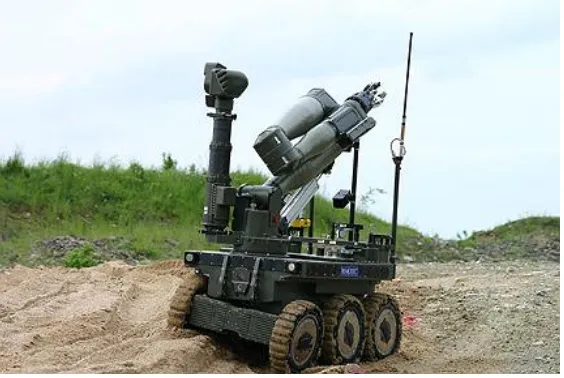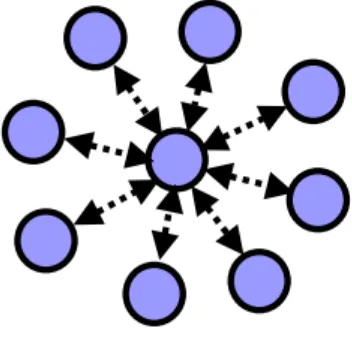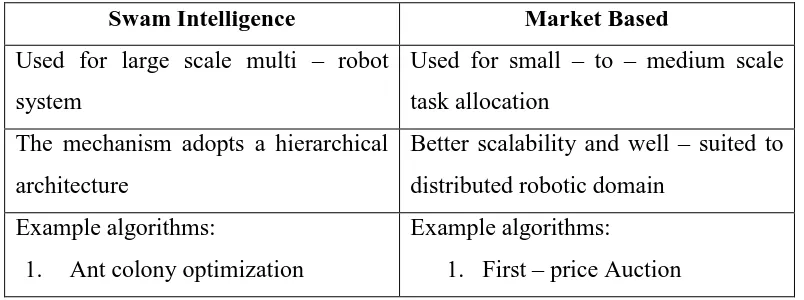MULTI ROBOT TASK ALLOCATION USING MARKET BASED APPROACH
FATIMAH BINTI YUSUF
A project report submitted in partial fulfillment of the requirement for the award of the
Master of Electrical Engineering
Faculty of Electrical and Electronic Engineering Universiti Tun Hussein Onn Malaysia
ABSTRACT
ABSTRAK
TABLE OF CONTENT
STUDENT’S DECLARATION 1
ACKNOWLEDGEMENT 2
ABSTRACT 3
ABSTRAK 4
TABLE OF CONTENT 5
LIST OF TABLES 8
LIST OF FIGURES 9
LIST OF SYMBOLS OR ABBREVIATIONS 11
Chapter 1 12
INTRODUCTION 12
1.1 Introduction 12
1.2 Problem Statement 15
1.3 Aim and Objectives 15
1.4 Scopes of Project 16
1.5 Rationale and Significant 16
1.6 Project Outline 17
Chapter 2 18
2.1 Introduction 18
2.2 Multi Robot System (MRS) 19
2.3 Multi Robot Task Allocation (MRTA) 21
2.3.1 Centralized versus Decentralized 22
2.3.2 Homogeneous versus Heterogeneous 24
2.3.3 MRTA model 25
2.3.4 Solution Model 26
2.3.5 Magnitude Used in Cost Function 27
2.4 SIT-MASR and SET-MASR Algorithm 27
2.5 Shortest Path 29
2.6 Dijkstra’s Algorithm 30
2.7 Summary 31
Chapter 3 32
METHODOLOGY 32
3.1 Introduction 32
3.2 Overview of the project 32
3.3 Dijkstra’s Algorithm 34
3.4 Market-Based Approach 37
3.5 Auction Algorithm 37
3.5.1 Task Announcement 39
3.5.3 Task Allocation 43
3.6 Global Cost Function 46
3.7 Summary 47
Chapter 4 48
RESULT AND ANALYSIS 48
4.1 Introduction 48
4.2 World Dimension 48
4.3 Initial Position (Starting Point) and Goal Position (Target Point) 49 4.4 Simulation of Task Allocation Using Auction Algorithm 50 4.5 Result of Total Path and Computational Time 51
4.6 Result of Graphical User Interface (GUI) 57
4.7 Summary 60
Chapter 5 61
CONCLUSION 61
5.1 Introduction 61
5.2 Summary of Outcome 61
5.3 Limitation 62
5.4 Recommendation 63
5.5 Conclusion 64
REFERENCE 65
LIST OF TABLES
Table 2.1 The differences between Swam Intelligence and Market Based Approach 23
Table 3.1: Dijkstra’s Algorithm 36
Table 3.2: The auctioneer algorithm [21] 39
Table 3.3: The bidder algorithm [21] 42
Table 3.4: The task assignment algorithm 43
Table 4.1: Solution computed for mission with two robots and three robots and
different number of waypoints 52
Table 4.2: Solution computed for mission with four robots and five robots and
different number of waypoints 54
Table 4.3: Solution computed for mission with 20 and 40 waypoints and different
LIST OF FIGURES
Figure 1.1: UAV: RQ-1A Predator furnished with missiles. 13 Figure 1.2: UGV: CUTLASS used for explosive ordnance disposal (EOD) missions
13 Figure 1.3: UUV: REMUS 100 application include mine countermeasure, harbour
security and debris field mapping 14
Figure 2.1: Interaction types in multi robot systems [10] 20 Figure 2.2: Illustration of centralized coordination of a team 22 Figure 2.3: A limitation of SIT-MASR algorithm [21] 28 Figure 2.4: The shortest path (A-C-D-F-E) between vertices A and E in the weighted
directed graph 29
Figure 2.5: Shortest path tree [30] 31
Figure 3.1: Flowchart of the project 33
Figure 3.2: Developing shortest path tree using Dijktra’s Algorithm. (a) Calculating the nearest distance from origin O, (b) Generating possible path, OAB and OC, (c) OABDT and OABEDT are two choices of complete shortest path and OC is
uncompleted path 35
Figure 3.3: Auction process [31] 38
Figure 3.4: Auctioneer Algorithm 40
Figure 3.5: Bidder Algorithm 42
Figure 4.1: Creating the workspace for the system 49 Figure 4.2: Positioning robot’s initial point and target point 50
Figure 4.3: Auction for the circled waypoint won by Robot 3 51 Figure 4.4: Relationship between total path length and computational time for (a) 2
robots and (b) 3 robots 53
Figure 4.5: Difference path developed due to increment of waypoint. 53 Figure 4.6: Total path length and computational time for 4 robots and 5 robots 55 Figure 4.7: Simulation result for 20 and 40 waypoints 57
Figure 4.8: GUI of the system 58
Figure 4.9: GUI interface with visibility line 59
LIST OF SYMBOLS OR ABBREVIATIONS
UAV Unmanned Aerial Vehicles
UGV Unmanned Ground Vehicles
UGV Unmanned Underwater Vehicles
ISR Intelligence, surveillance and reconnaissance MRTA Multi robot task allocation
MRS Multi-robot systems
ST Single-task robots
MT Multi-task robots
SR Single-robot tasks
MR Multi-robot tasks
IA Instantaneous assignment
TA Time-extended assignment
MINISUM Minimize the sum of the robot path costs over all robots. MINIMAX Minimize the maximum robot path costs over all robots MINIAVE Minimize the average target path costs over all targets OPSP One-Pair Shortest-Paths
SSSP Single-Source Shortest-Paths APSP All-Pairs Shortest-Paths
RPC Robot path cost
GUI Graphical User Interface
CHAPTER 1
INTRODUCTION
1.1 Introduction
In late 1980’s, researchers started investigating the issues regarding multi robot system. As robots become an integral part of human life, people charge them with increasingly varied from simple task like house cleaning purpose up to difficult tasks including planetary exploration, manufacturing and construction, medical assistance, search and rescue in military field, port and warehouse automation. Works in challenging environment require robots to work collaboratively in teams rather than working alone [1].
Nowadays, the development of multiple mobile robot system has been moved to larger team size and greater heterogeneity of either robots or tasks. From centralized and homogeneous robot system, researchers began to investigate on decentralized and heterogeneous robot systems. Addition to task constraints, uncertainty and unforeseen changes, the complexity of the mission arises to optimise the robot technologies and enhance the problems faced [2].
Vehicles (UUV) as shown in Figures 1.1 – 1.3 below. All these UxVs commonly used for civilian and military missions. UAV has been used for civilian applications such as weather forecasting, environmental research, search and rescue missions, and observation during wildfire incidents and traffic control while for military domains, UAV has been approached for intelligence, surveillance and reconnaissance (ISR), security and air defence, search, attack, destroy and battle damage assessment [3] . In military domains, UGV primarily utilized for ordnance disposal, mine clearing operation, NBC decontamination and also as a goods transport, convoying and logistics [4].
Figure 1.1: UAV: RQ-1A Predator furnished with missiles.
[image:12.595.179.461.483.672.2]Figure 1.3: UUV: REMUS 100 applications include mine countermeasure, harbour security and debris field mapping
The main issue in distributed multi robot coordination is the multi robot task allocation (MRTA) problem that has recently become a key research topic. Task allocation is the problem of mapping tasks to robots, such that the most suitable robot is selected to perform the most appropriate task, leading to all tasks being satisfactorily completed [5]. Ideally, in MRTA approaches, robots will act as a team to allocate resources amongst themselves in a way to accomplish their mission efficiently and reliably. The collaboration can lead to faster task completion, decreased the travelled distance and allow the completion of tasks which is impossible for single robots. Robots should, whenever possible, cooperate strongly in order to maximize their overall task performance.
1.2 Problem Statement
For most of the missions, UAVs must traverse from their home base to the area of interest in order to accomplish the missions. In any mission, the cost of traversal is crucial and has to be taken into account as this will ensure that the UAVs will last longer and the maintenance cost is low [3]. The cost functions are measured in terms of time to reach a goal, distance travelled and energy consumption.
The mission cost can be reduced by minimising the travelling distance of UAVs in a mission. By reducing the distance, it is assumed that the energy consumption can also be optimised.
Hence, there is a need to formulate an algorithm that is capable of doing multi-robot task planning so that a mission can be accomplished in the shortest time possible, in which the traversal distance is optimal.
1.3 Aim and Objectives
The aim of this project is to design an algorithm to accomplish a task/mission by a team of UAVs (mobile robots) that work collaboratively. The mobile robots will share the prime target and able to visit several waypoints set in the system before reaching the prime target, but it must visit the nearest waypoint.
A number of objectives are set in order to achieve the target above and are structured as follows:
a) To find the shortest distance from initial point to the prime target in order to minimise the total path length and energy consumption.
b) To design an algorithm based on Market based approach using a programming language (MATLAB)
1.4 Scopes of Project
The scopes of this project are structured as follows:
a) The robots are not required to return to their starting positions. b) Minimize the total distance of all robot paths, not individual path. c) The mobile robot are not necessarily depart from the same depot d) There will be no existence of unexpected obstacle.
e) The robots will not share the same waypoint, therefore no crash happen between the robots
f) The waypoints positions are generated randomly.
g) The number of waypoints visited by each robot is not restricted.
It is assumed that all robots are able to announce and bid for tasks. Every robot is characterized by a unique identifier, an initial position, velocity, field of view, and the task to which it is assigned. It is also assumed that each robot has the knowledge about its own cost of the task from the beginning, but a robot does not know about the cost of other robots as it does not know about their positions.
1.5 Rationale and Significant
The impact of this project is to help the robot developer to have a good technique of multi robot task assignment in the workspace in order to delegate task among others before achieving the desired point. The project is intended to improve the efficiency of robot motion by taking the shortest path from the initial point to prime target.
1.6 Project Outline
The thesis comprise in 5 chapters together including Chapter 1 is on Introduction, Chapter 2 is Literature Review, Chapter 3 is Methodology, Chapter 4 contains result and discussion followed by last chapter which is Conclusion.
Chapter 1 will discuss the introduction of the thesis by outlining the overview of the project. It will start with problem statement, objectives of the project, the project scope and the impact and significant of the project.
In Chapter 2, it reviews the previous works from thesis, journals, conference paper and experiments that related to the project. The literature review includes Multi Robot System, Multi Robot Task Allocation, Market Based Method and Shortest Path Algorithm.
Chapter 3 represents the research methodology of the project. The step by step procedure used to run the project will be explained in details. It will also include the flowchart of processes involved in software development of entire project.
Chapter 4 will contain the simulation results and its respective analysis. The result will be discussed and explained with the aid of diagrams. The comparison of every finding will be explicated in detail.
CHAPTER 2
LITERATURE REVIEW
2.1 Introduction
This chapter discusses several algorithms that have been studied regarding multi robot task allocation problem. Among a variety of task allocation problems studied in multi-robot systems (MRS) and some related domains, works are selectively introduced based on the outstanding achievement and improvement in MRTA and have similarity to the aim of this thesis.
2.2 Multi Robot System (MRS)
Over the past decade, a significant shift of focus has occurred in the field of mobile robotics, for example, human assistance, urban search and rescue, topological navigation, and multi-robot data retrieval [6]. The advantages of multi-robot systems over single-robot operations include faster task completion, increased robustness, higher quality solutions , and the completion of task impossible for single robots [1]. Nowadays trends, researchers began to investigate on multiple robot rather than single robot and employed in a variety of applications that require complex coordinated tasks. From early work on simple loosely-coupled tasks such as foraging [7] to work on military purposes [5], [8].
Multi robot system (MRS) can be defined as a set of robots working collaboratively in the same environment to achieve system goals [9]. Dangerous or hazardous environment which are not suitable for human being such as removing toxic waste, exploring planets, and removing landmines may require the use of robots [8]. It is difficult to classify MRS in level of autonomy [9] as robotic systems may range from simple sensors up to complex humanoid machine, but it can be characterized in the following aspects:
i) the rationale for the design of the MRS;
ii) the basic functionalities and technologies (both hardware and software) used in the MRS development;
iii) the tasks that the robots should perform and the intended application domains.
Figure 2.1: Interaction types in multi robot systems [10]
Collective interaction is the simplest type of interaction among the four, in which a set of robots do share goals and their actions are beneficial to their teammates, but they are not aware of other members on the team. An example of this type of interaction [11], the work focuses on creating systems of robots that can perform biologically-relevant tasks, such as foraging, swarming, flocking, herding, formation-keeping, and so forth. Combination of larger numbers of robots results in the global goal being achieved.
While cooperative interaction leads robots to share their goals and do aware of other entities. In multi-robot systems, an example of this type of interaction is multiple robots working together and reasoning about each other’s capabilities in order to accomplish a joint task. The fundamental question: “which robot should execute which task?” always being asked by researchers that interest in cooperative robot system [12]. In [13], the multi-robot system is entitled to box pushing task where they allocate and coordinate tasks that require tightly coupled cooperation among the robots and it must do so in a fault-tolerant manner.
independently, due to sensor limitations, they could work together with other robots by sharing sensory capabilities to help all team members reach their individual goal locations [10]. This type of collaboration is sometimes called coalition formation, and has been illustrated in [14].
Finally, coordinative interaction, where robots are aware of each other but they do not share a common goal and their actions are not helpful to other team members. The only sharing part for coordinative interaction is working workspace.
The robots must work to coordinate their actions to minimize the amount of interference between themselves and other robots. Multi-robot path planning techniques or traffic control are commonly used in these domains.
2.3 Multi Robot Task Allocation (MRTA)
Multi Robot Task Allocation (MRTA) is defined as the problem that determines which robot should execute which task [12]. The purpose of task allocation is to assign individual tasks to robots so that the performance of the system will be greatly enhanced, which can minimize the overall operation cost or maximize the system utility [1], [8]. In other words, MRTA problem is to find the most productive and efficient way to assign tasks to robots in order to achieve the system goal.
2.3.1 Centralized versus Decentralized
[image:21.595.228.404.357.526.2]Centralized multi-robot systems differ from decentralized multi-robot systems by having a central controller which is responsible for managing all the available resources. In the centralized approach, a single agent works as a leader and controls the behaviour of the entire group [9]. Each robot needs to communicate with central planner in order to compute its allocation and the information is broadcasted to whole team. But, if the communication is lost, the system meets a failure. The main advantage of centralized approach is the ability to produce an optimal planning since a decision making agent utilizes the relevant information from all robots, thus making it much easier for the system. This method is suitable for time-optimal task allocation. The centralized approach is illustrated in Figure 2.2 below.
Figure 2.2: Illustration of centralized coordination of a team
Distributed approaches can be differentiated further by the architecture through which robots coordinate: behaviour based architecture; swam intelligence based architecture; and market based architecture. The basic concept of behaviour based architecture is that a collection of behaviours that perform certain goals can be tailored to the domain. Robots select the behaviours according to the current state of a team and an environment. The robots can also execute several tasks at the same time by conducting multiple behaviours in parallel. In [7], the concepts has been applied for formation control inspired from a flock of bird and schools of fish and being tested for DARPA’s HMMWV-based Unmanned Ground Vehicles.
Swam intelligence based architecture is inspired by biology, especially the collective behaviour of insect colonies like ants and wasps. The ant system algorithm employs artificial pheromone, like real ants use pheromone for path selection in ant colony, as a clue for agents to make decisions.
While in market based approach, robots are designed as self-interested agents that operate in a virtual economy [1]. Both the tasks that must be completed and the available resources are commodities of measurable worth that can be traded like auction and bidder. Most of decentralized systems are auction-based algorithm such as prim allocation algorithm [15], Markov decision process [16] and S+T algorithm [17].
[image:22.595.106.508.622.772.2]Table 2.1 summaries the characteristics of swam intelligence and market based approach which clearly differentiate the application of them.
Table 2.1 The differences between Swam Intelligence and Market Based Approach
Swam Intelligence Market Based
Used for large scale multi – robot system
Used for small – to – medium scale task allocation
The mechanism adopts a hierarchical architecture
Better scalability and well – suited to distributed robotic domain
Example algorithms:
1. Ant colony optimization
Example algorithms:
2. Particle swarm & ant colony optimization
2. Dynamic Role Assignment 3. Murdoch
Good features:
1. Self-organizing ability in unknown environment
2. Emergent and adaptive behaviour through simple interaction among individuals 3. Used implicit communication 4. Used robot coalition which
robots cooperate to complete task – pushing box
Good features:
2. Robots act as self-interest agent and bid for tasks
3. Robot with highest bid win and get the task
4. Bids are adjusted to robot interest (capacity) to carry out the goal
5. Need communication mechanism between robots
2.3.2 Homogeneous versus Heterogeneous
A team of robots can be composed of either homogeneous or heterogeneous members. Robots in a homogeneous team have identical skills and do share the same capacities. The characteristics make the algorithms designed for homogeneous groups much easier compared to heterogeneous team. VC TA algorithm [18] is implemented in vacancy chain where it demonstrates how Reinforcement Learning can be used to make vacancy chains emerge in a group of Behaviour-Based robots. However, the advantage of homogeneous team causes wasting of resource and the lack of practical applicability[6], [8].
Heterogeneous robot team members play different roles as sometimes they differ in physical capabilities depending on hardware and control software installed as in team games where robots play different positions.
REFERENCE
[1] M. B. Dias, R. Zlot, N. Kalra, and a. Stentz, “Market-Based Multirobot Coordination: A Survey and Analysis,” Proc. IEEE, vol. 94, no. 7, pp. 1257– 1270, Jul. 2006.
[2] B. P. Gerkey, “A formal analysis and taxonomy of task allocation in multi-robot systems,” vol. 23, no. 9, pp. 939–954, 1998.
[3] T. Cox, C. Nagy, M. Skoog, I. Somers, and R. Warner, “Civil UAV capability assessment,” NASA, Tech. Rep., Draft Version, no. December, 2004.
[4] NATO, Research and Technology Organisation, Multi-Robot Systems in Military Domains, Technical., vol. 323, no. December. North Atlantic Treaty Orgarnisation, 2008.
[5] B. P. Gerkey and M. J. Mataric, “Multi-robot task allocation: analyzing the complexity and optimality of key architectures,” in 2003 IEEE International Conference on Robotics and Automation (Cat. No.03CH37422), 2003, vol. 3, pp. 3862–3868.
[6] X. Jia and M. Meng, “A survey and analysis of task allocation algorithms in multi-robot systems,” Robot. Biomimetics (ROBIO), 2013 …, no. December, pp. 2280–2285, 2013.
[7] T. Balch, R. C. Arkin, and S. Member, “Behavior-Based Formation Control for Multirobot Teams,” vol. 14, no. 6, pp. 926–939, 1998.
[8] M. Kim, “Distributed task allocation for multi-robot systems in military domain,” vol. 9, 2011.
[9] A. Farinelli, L. Iocchi, and D. Nardi, “Multirobot systems: a classification focused on coordination.,” IEEE Trans. Syst. Man. Cybern. B. Cybern., vol. 34, no. 5, pp. 2015–28, Oct. 2004.
[10] L. E. Parker, “Distributed Intelligence : Overview of the Field and its Application in Multi-Robot Systems,” 2007.
[11] C. R. Kube, H. Zhang, X. Wang, and A. C. Tg, “Controlling Collective Tasks With An ALN,” no. C, pp. 0–4, 1993.
[13] B. P. Gerkey and M. J. Mataric, “Sold!: auction methods for multirobot coordination,” IEEE Trans. Robot. Autom., vol. 18, no. 5, pp. 758–768, Oct. 2002.
[14] F. Tang and L. E. Parker, “A Complete Methodology for Generating Multi-Robot Task Solutions using ASyMTRe-D and Market-Based Task Allocation,” no. April, pp. 10–14, 2007.
[15] M. Lagoudakis and M. Berhault, “Simple auctions with performance guarantees for multi-robot task allocation,” … Robot. Syst. …, 2004.
[16] H. Hanna, “Decentralized approach for multi-robot task allocation problem with uncertain task execution,” 2005 IEEE/RSJ Int. Conf. Intell. Robot. Syst., pp. 535–540, 2005.
[17] A. Viguria, I. Maza, and A. Ollero, “S+T: An algorithm for distributed multirobot task allocation based on services for improving robot cooperation,” 2008 IEEE Int. Conf. Robot. Autom., pp. 3163–3168, May 2008.
[18] T. S. Dahl, M. J. Mataric, and G. S. Sukhatme, “Multi-robot task-allocation through vacancy chains,” in 2003 IEEE International Conference on Robotics and Automation (Cat. No.03CH37422), pp. 2293–2298.
[19] L. Luo, N. Chakraborty, and K. Sycara, “Distributed algorithm design for multi-robot task assignment with deadlines for tasks,” Robot. Autom. ( …, pp. 3007–3013, 2013.
[20] S. Misra and B. J. Oommen, “Dynamic algorithms for the shortest path routing problem: learning automata-based solutions.,” IEEE Trans. Syst. Man. Cybern. B. Cybern., vol. 35, no. 6, pp. 1179–92, Dec. 2005.
[21] A. Viguria, I. Maza, and A. Ollero, “SET: An algorithm for distributed multirobot task allocation with dynamic negotiation based on task subsets,” in Proceedings 2007 IEEE International Conference on Robotics and Automation, 2007, no. April, pp. 3339–3344.
[22] T. Lemaire, R. Alami, and S. Lacroix, “A distributed tasks allocation scheme in multi-UAV context,” Robot. Autom. 2004. …, pp. 3622–3627, 2004.
[23] H. Choi, L. Brunet, and J. How, “Consensus-based decentralized auctions for robust task allocation,” Robot. IEEE Trans., vol. 25, no. 4, pp. 912–926, 2009. [24] T. Dahl, M. Mataric, and G. Sukhatme, “Multi-robot task-allocation through
vacancy chains,” Robot. Autom. …, 2003.
[26] U. Meyer, “Design and Analysis of Sequential and Parallel Single – Source Shortest – Paths Algorithms,” 2002.
[27] “Proof for Dijkstra ’ s Algorithm,” pp. 1–2.
[28] N. Jasika, N. Alispahic, A. Elma, K. Ilvana, L. Elma, and N. Nosovic, “Dijkstra’s shortest path algorithm serial and parallel execution performance analysis,” MIPRO, 2012 Proc. 35th Int. Conv., pp. 1811–1815, 2012.
[29] C. Stein, T. Cormen, R. Rivest, and C. Leiserson, “Introduction to algorithms,” MIT Press, pp. 595–601, 2001.
[30] E. Millinocket and M. Dodge, “13.1 Shortest Paths,” Algorithms, pp. 1–11, 2000.
[31] A. Allain, “Dijkstra’s Algorithm For Shortest Paths.” pp. 1–3, 2012. [32] C. Data, “Dijkstra ’ s algorithm,” 1959.
[33] L. Lin and Z. Zheng, “Combinatorial bids based multi-robot task allocation method,” Robot. Autom. 2005. ICRA 2005. …, no. April, pp. 45–50, 2005. [34] M. B. Dias and A. Stentz, “Opportunistic optimization for market-based


![Figure 2.1: Interaction types in multi robot systems [10]](https://thumb-us.123doks.com/thumbv2/123dok_us/8766025.896469/19.595.195.441.80.262/figure-interaction-types-multi-robot-systems.webp)

